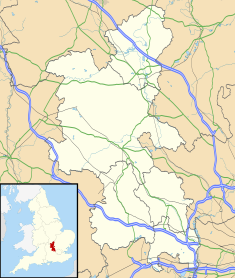Beaconsfield Town Hall
| Beaconsfield Town Hall | |
|---|---|
Beaconsfield Town Hall | |
| Location | Penn Road, Beaconsfield |
| Coordinates | 51°36′43″N 0°38′45″W / 51.6119°N 0.6458°WCoordinates: 51°36′43″N 0°38′45″W / 51.6119°N 0.6458°W |
| Built | 1936 |
| Architectural style(s) | Neo-Georgian style |
 Shown in Buckinghamshire | |
Beaconsfield Town Hall is a municipal building in Penn Road, Beaconsfield, Buckinghamshire, England. The structure accommodates the offices and meeting place of Beaconsfield Town Council.
History[]
After significant population growth, largely due to the popularity of Beaconsfield as a residential district, the area became an urban district in 1894.[1] A group of local business leaders formed a private company to raise finance for the construction of a town hall on the west side of Station Road between the junctions with Gregories Road and Burkes Road.[2] Built at a cost of £3,500, it became known as the Coronation Town Hall, as it was completed just in time for the Coronation of George V and Mary, and was officially opened by the High Sheriff of Buckinghamshire, William Baring du Pré, on 14 June 1911.[2] The urban district council also leased space in a second building, located close to the Coronation Town Hall, in December 1914: council leaders established their own council chamber on the first floor of the leased building.[2]
In the early 1930s, civic leaders decided to co-locate all their functions in one building; the site they selected was open land on the east side of Station Road, some 300 yards (270 m) further north along the road from to the previous buildings and just south of the old Railway Hotel.[3] The new building was designed in the Neo-Georgian style, built in brown brick with stone dressings at a cost of £7,600 and was officially opened by the Chairman of Buckinghamshire County Council, Sir Leonard West, on 23 May 1936.[2] The design involved a symmetrical main frontage with eleven bays facing onto Station Road; the central section of five bays, which slightly projected forward, featured a doorway on the ground floor and five French doors with a wrought-iron balcony on the first floor. The other bays were fenestrated with sash windows and, at roof level, there was a parapet and clock turret. Internally, the principal room was the council chamber on the first floor.[4]
The town hall continued to serve as the headquarters of the urban district council for much of the 20th century but ceased to be the local seat of government after the enlarged Beaconsfield Borough Council (subsequently renamed South Bucks District Council) was formed at Windsor Road in Slough in 1974.[5][6] The town hall was subsequently used, in part, as the offices and meeting place of Beaconsfield Town Council and as an approved venue for weddings and civil partnership ceremonies.[7]
A park known as the Beaconsfield Town Hall gardens was established in front of the town hall in 2003. The gardens included a seating area with a gazebo and plaques to celebrate local themes, including a street fair, a lute player, a coach and horses, a railway and a model village.[8] The plaques also celebrated famous former residents such as the writers, Enid Blyton and G. K. Chesterton.[9] Ornaments included small iron figures, designed by the artist, Steffi Goddard, depicting Blyton's characters, Noddy and Big Ears,[10][11] and an armillary sphere sundial in blackened brass.[12] In 2012, a figure depicting the official mascot for the 2012 Summer Olympics, Wenlock, was also installed in the garden.[13]
References[]
- ^ "Beaconsfield UD". Vision of Britain. Retrieved 21 August 2021.
- ^ a b c d "The Town Hall". Beaconsfield and District Historical Society. Retrieved 21 August 2021.
- ^ "Ordnance Survey Map". 1925. Retrieved 21 August 2021.
- ^ "Beaconsfield Chambers". Beaconsfield Town Council. Retrieved 21 August 2021.
- ^ Local Government Act 1972. 1972 c.70. The Stationery Office Ltd. 1997. ISBN 0-10-547072-4.
- ^ "No. 46547". The London Gazette. 18 April 1975. p. 5073.
- ^ "Hall Future in Balance". Bucks Free Press. 23 November 2005. Retrieved 21 August 2021.
- ^ "Beaconsfield Town Hall Green" (PDF). Goodger Design Associates. Retrieved 21 August 2021.
- ^ "Noddy and Big Ears to grace Beaconsfield again". 22 May 2003. Retrieved 21 August 2021.
- ^ "Enid Blyton plaque unveiled in Beaconsfield". BBC. 8 May 2014. Retrieved 21 August 2021.
- ^ Cohen, Nadia (2018). The Real Enid Blyton. Pen and Sword. ISBN 978-1526722034.
- ^ "Beaconsfield Town Hall garden, Beaconsfield". The British Sundial Society. 20 August 2020. Retrieved 21 August 2021.
- ^ "Wenlock the mascot gets 'beaten up'". Beaconsfield Advertiser. 2012. Retrieved 21 August 2021.
- Government buildings completed in 1936
- City and town halls in Buckinghamshire
- Beaconsfield